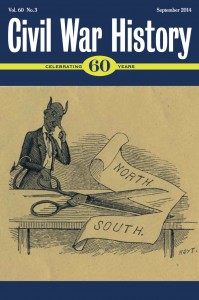September 2014, Volume 60, No. 3
Jun 17th, 2014“THE FIRST SECESSIONIST WAS SATAN”: SECESSION AND THE POLITICS OF HELL IN CIVIL WAR AMERICA
By: Edward J. Blum
Examining speeches, sermons, soldiers’ letters, novels, rumors, and visual imagery from the Civil War, this essay suggests that the widespread claim among Unionists that “Satan” was the “first secessionist” was a crucial element in Unionist moral politics. It was an enduring position even as emancipation and hard war altered the conflict, and it bound Democrats and Republicans, women and men, politicians and privates in ways that anti-slavery positions did not. With this argument, Unionists positioned the ideology of secession not in the “right of revolution” from the Founding Fathers of the American Revolution, but instead in an earlier era, before the creation of humanity, and from the demonic. Satan as the first secessionist provided Unionists with a weapon to attack Confederate claims to the sacred and the South’s honor culture, while it also allowed Unionists to denounce Confederate action, rather than Confederate essence. Incarnating evil outside of Confederate bodies, most graphically on letter envelopes of the age, Unionists presented themselves as seeking to vanquish demonic Confederate influences, not destroy Confederate Southerners themselves.
“WE ARE A BAND OF BROTHERS”: MANHOOD AND COMMUNITY IN CONFEDERATE CAMPS
By: James J. Broomall
This essay challenges the notion that Confederate soldiers were incapable or unable to form meaningful personal relationships during military service because of the demands of an antebellum honor-based culture. Instead, I argue many soldiers came to believe they had shared a unique life in the army, which forever bound them to other veterans. Comradeship, built especially at the regimental company level, encouraged intimacy among soldiers, thereby fostering emotional connections seldom seen in the antebellum era. Soldiers’ affinities for each other transcended the wartime era demonstrating the integrity of their bonds. However, camp life also created contradictions in men’s lives as they were forced to live under difficult conditions for protracted periods; these trials tested the limits of soldiers’ bonds and demanded new models of manliness.
Edward J. Blum is professor of history at San Diego State University. He is the author of Reforging the White Republic: Race, Religion, and American Nationalism, 1865-1898 (2005) and co-author with Paul Harvey of The Color of Christ: The Son of God and the Saga of Race in America (2012).
James J. Broomall is an assistant professor in the Department of History at the University of North Florida. A scholar of the nineteenth century, he has both presented on and written about this topic in numerous forums and is currently writing a manuscript-length study of masculinity and emotions in the Civil War-era South. His work has appeared most recently in the edited collection Creating Citizenship in the Nineteenth-Century South and The Journal of the Civil War Era.
Reviews:
Sternhell, Yael A. Routes of War: The World of Movement in the Confederate South. Reviewed by Daniel E. Sutherland.
Kantrowitz, Stephen. More than Freedom: Fighting for Black Citizenship in a White Republic, 1829–1889. Reviewed by Dylan C. Penningroth.
Janney, Caroline E. Remembering the Civil War: Reunion and the Limits of Reconciliation. Reviewed by Thomas J. Brown.
Humphreys, Margaret. Marrow of Tragedy: The Health Crisis of the American Civil War. Reviewed by John S. Haller Jr.
Davis, Stephen. What the Yankees Did to Us: Sherman’s Bombardment and Wrecking of Atlanta. Reviewed by Joseph M. Rizzo.
Dobak, William A. Freedom by the Sword: The U.S. Colored Troops, 1862–1867. Reviewed by Ryan W. Keating.
Stauffer, John and Benjamin Soskis. The Battle Hymn of the Republic: A Biography of the Song That Marches On. Reviewed by Christian McWhirter.
Hess, Earl J. Kennesaw Mountain: Sherman, Johnston, and the Atlanta Campaign. Reviewed by Michael Shane Powers.
Hasegawa, Guy. Mending Broken Soldiers: The Union and Confederate Programs to Supply Artificial Limbs. Reviewed by Jeffrey McClurken.
Kelman, Ari. A Misplaced Massacre: Struggling over the Memory of Sand Creek. Reviewed by Amy Breakwell.
Keefer, Bradley S. Conflicting Memories on the “River of Death”: The Chickamauga Battlefield and the Spanish-American War, 1863–1933. Reviewed by Stephen Rockenbach.
Towns, W. Stuart. Enduring Legacy: Rhetoric and Ritual of the Lost Cause. Reviewed by Philip D. Dillard.
Cox, Karen L., ed. Destination Dixie: Tourism and Southern History. Reviewed by Minoa D. Uffelman.
Jones, Marian Moser. The American Red Cross from Clara Barton to the New Deal. Reviewed by Patricia Ann Owens.


